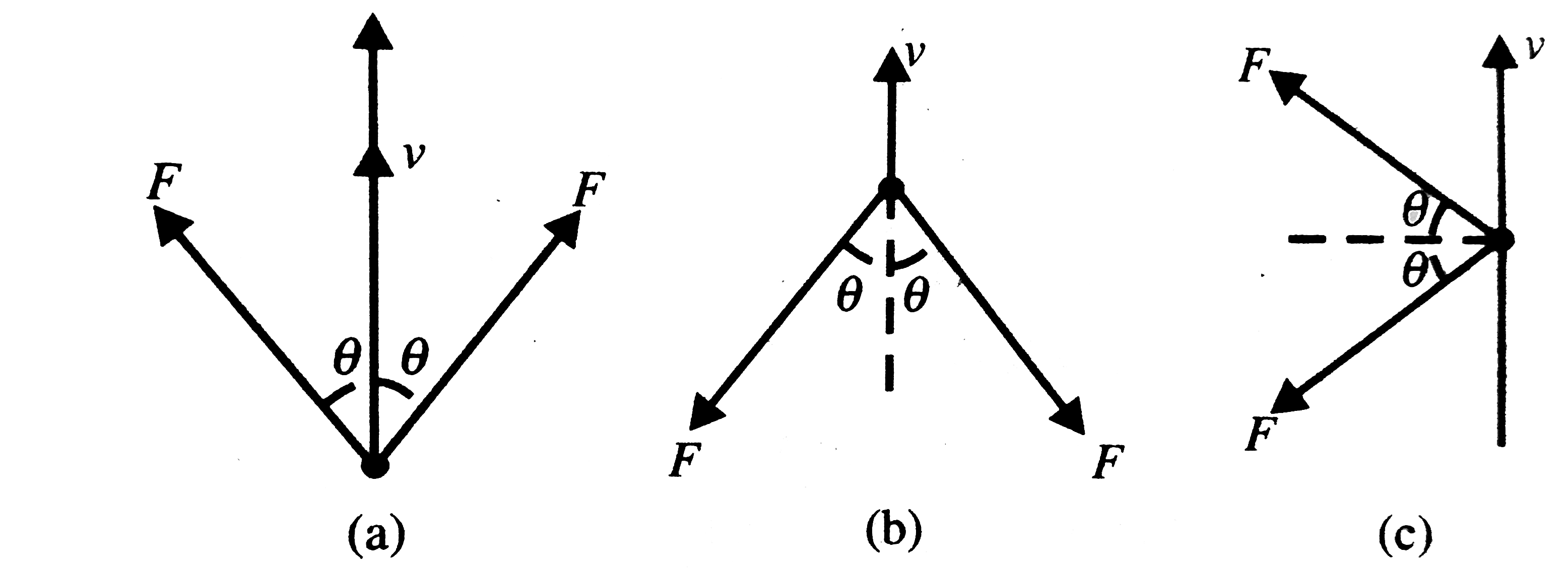A particle is acted upon by a force of constant magnitude which is always perpendiculr to the velocity of the particle. The motion of the particle takes place in a plane. It follows that
its velocity is constant
its acceleration is constant
its kinetic energy is constant
it move in a circular path
The correct Answer is:C, D
To solve the problem step by step, we will analyze the situation where a particle is acted upon by a force of constant magnitude that is always perpendicular to its velocity.
Step 1: Understand the Given Information
We have a particle that is subjected to a constant force. The key points are:
- The force has a constant magnitude.
- The force is always perpendicular to the velocity of the particle.
- The motion occurs in a plane.
Step 2: Analyze the Force and Velocity Relationship
Since the force is always perpendicular to the velocity, we can conclude that:
- The direction of the force does not do any work on the particle because work is defined as W=F⋅S=FScosθ, where θ is the angle between the force and displacement vectors.
Step 3: Calculate the Work Done
Since the force is perpendicular to the velocity, the angle θ is 90 degrees. Thus, we have:
W=FScos(90∘)=FS⋅0=0
This means that the work done by the force on the particle is zero.
Step 4: Apply the Work-Energy Theorem
According to the work-energy theorem, the work done on an object is equal to the change in its kinetic energy:
W=Kfinal−Kinitial
Since we found that W=0, we can write:
0=Kfinal−Kinitial
This implies:
Kfinal=Kinitial
Thus, the kinetic energy of the particle remains constant.
Step 5: Conclusion
Since the kinetic energy of the particle does not change, we conclude that the kinetic energy of the particle remains constant throughout its motion.
Final Answer
The kinetic energy of the particle is constant.
---
We have a particle that is subjected to a constant force. The key points are:
- The force has a constant magnitude.
- The force is always perpendicular to the velocity of the particle.
- The motion occurs in a plane.
Since the force is always perpendicular to the velocity, we can conclude that:
- The direction of the force does not do any work on the particle because work is defined as W=F⋅S=FScosθ, where θ is the angle between the force and displacement vectors.
Since the force is perpendicular to the velocity, the angle θ is 90 degrees. Thus, we have:
W=FScos(90∘)=FS⋅0=0
This means that the work done by the force on the particle is zero.
According to the work-energy theorem, the work done on an object is equal to the change in its kinetic energy:
W=Kfinal−Kinitial
Since we found that W=0, we can write:
0=Kfinal−Kinitial
This implies:
Kfinal=Kinitial
Thus, the kinetic energy of the particle remains constant.
Since the kinetic energy of the particle does not change, we conclude that the kinetic energy of the particle remains constant throughout its motion.
The kinetic energy of the particle is constant.
Topper's Solved these Questions
- WORK, POWER AND ENERGYBOOK - DC PANDEY ENGLISHCHAPTER - WORK, POWER AND ENERGYEXERCISE - C Comprehension Type Questions
18 Videos
- WORK, POWER AND ENERGYBOOK - DC PANDEY ENGLISHCHAPTER - WORK, POWER AND ENERGYEXERCISE - D Matrix Matching Type Questions
10 Videos
- WORK, POWER AND ENERGYBOOK - DC PANDEY ENGLISHCHAPTER - WORK, POWER AND ENERGYEXERCISE - A Only One Option is Correct
42 Videos
- WORK, ENERGY AND POWERBOOK - DC PANDEY ENGLISHCHAPTER - WORK, ENERGY AND POWEREXERCISE - MEDICAL ENTRACES GALLERY
33 Videos
Similar Questions
A particle is acted upon by a force of constant magnitude which is always perpendicular to the velocity of the particle. The motion of the particle takes place in a plane. It follows that
View SolutionA particle is acted upon by a force of constant magnitude which is always perpendicular to the velocity of the particle. The motion of the particle takes place in a plane. It follows that
View Solution
Knowledge Check
A particle is acted upon by a force of constant magnitude which is always perpendicular to the velocity of the particle. The motion of the particle takes place in a plane. It follows that
Aits velocity is constantBits acceleration is constantCits kinetic energy is constantDit moves in a straight line.the circular motion of a particle with constant speed is
Aperiodic and simple harmonicBsimple harmonic but not periodicCneither periodic nor simple harmonicDperiodic but not simple harmonic
A particle is acted upon by a force of constant magnitude which is always perpendicular to the velocity of the particle. The motion of the particle takes place in a plane. It follows that
View SolutionWhen the force of constant magnitude always act perpendicular to the motion of a particle then :
View SolutionThe magnetic force on a charged particle is always perpendicular to its velocity. Can the magnetic force change the velocity of the particle? Speed of the particle?
View SolutionA particle of mass m is acted on by two forces of equal magnitude F maintaining their orientation relative to the velocity v as shown in Fig. The momentum of the particle

View SolutionDescribe the motion of a particle acted upon by the force:
View SolutionA particle experience a force of 10 N which is constant in magnitude and is always acting towards origin. Calculate the work done by the force on the particle during its displacement from (1,2,3) to (−1,−2,3):
View Solution
